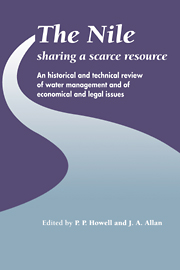 The Nile: Sharing a Scarce Resource
The Nile: Sharing a Scarce Resource Published online by Cambridge University Press: 05 February 2012
Nile Basin water allocation and management
The review of the status of the Nile resource, of the planning options of the major users and of economic, political and legal issues associated with the allocation and use of Nile water in the preceding chapters has shown that environmental and development factors have begun to interact in various parts of the Basin which have environmental, economic and political outcomes which require careful management.
The geography of Nile water has been shown to be significant in that the location of individual sites within the Basin and of individual political units determine whether the sites or countries have a potential to be water exporting or water importing. In the past when technologies for controlling water were not very effective, the advantage lay with the downstream riparians. The advantage of the downstream location was enhanced by the terrain of the lower Nile valley which is flat, slows down the flow of the river and has the capacity to accumulate the eroded silt from Ethiopia. Until the second half of the twentieth century the lower Nile countries therefore had sufficient land, sufficient water and the necessary institutions to develop Nile waters to support enduring rural and urban livelihoods.
By the second half of the twentieth century the development context had begun to change. The environmental advantage still appeared to lie with the downstream countries but the major user of water, Egypt, began to find that the volume of water available was no longer adequate for its sectoral needs.
To save this book to your Kindle, first ensure [email protected] is added to your Approved Personal Document E-mail List under your Personal Document Settings on the Manage Your Content and Devices page of your Amazon account. Then enter the ‘name’ part of your Kindle email address below. Find out more about saving to your Kindle.
Note you can select to save to either the @free.kindle.com or @kindle.com variations. ‘@free.kindle.com’ emails are free but can only be saved to your device when it is connected to wi-fi. ‘@kindle.com’ emails can be delivered even when you are not connected to wi-fi, but note that service fees apply.
Find out more about the Kindle Personal Document Service.
To save content items to your account, please confirm that you agree to abide by our usage policies. If this is the first time you use this feature, you will be asked to authorise Cambridge Core to connect with your account. Find out more about saving content to Dropbox.
To save content items to your account, please confirm that you agree to abide by our usage policies. If this is the first time you use this feature, you will be asked to authorise Cambridge Core to connect with your account. Find out more about saving content to Google Drive.